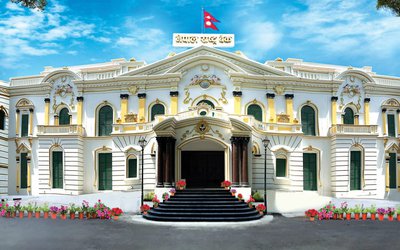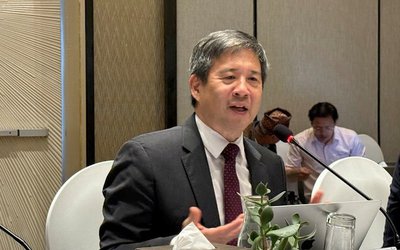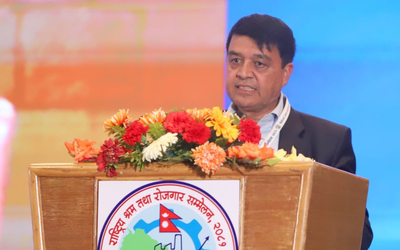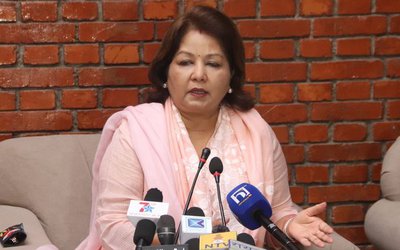
Just after holding Nepal Investment Summit weeks ago, Nepalese officials have another event to feel jubilation about. With the announcement of Asian Development Bank that Nepal's economy is set to grow 6.2 percent in the current fiscal year, officials have a reason to be optimistic.
As Nepal is expecting to go for high growth, ADB's recent announcement gives them a sigh of relief. Presenting its 13th five year plan, the government has forecast that Nepal’s per capita income will reach $1,400 by the end of the 15th periodic plan in fiscal year 2023-24.
The government has stated that Nepal will graduate from the least developed country status to the league of developing nations by 2022 and to a middle income country by 2030.
Nepal’s economy is anticipated to grow at 6.2% in fiscal year (FY) 2019 and 6.3% in FY2020, says the latest Asian Development Bank (ADB) Nepal Macroeconomic Update.
“The outlook is for a stable growth on the back of strong domestic demand, fueled by a larger budget allocation to subnational governments and accelerated post-earthquake reconstruction,” said Mukhtor Khamudkhanov, ADB’s Country Director for Nepal. “Challenges to smooth implementation of fiscal federalism and maintaining fiscal discipline at large could pose potential risks to the outlook. Nepal has the potential to achieve and sustain higher growth rate over a long period of time if these challenges are addressed.”
The agriculture sector will likely grow from 2.8% in FY2018 to 4.5% in FY2019, owing to a good monsoon that is expected to boost paddy production to 5.5 million tons, a rise of 8.4% from the previous year. The industry sector is expected to expand by 7.1% in FY2019 buoyed by improved electricity supply and efforts to improve the investment climate. And the services sector will likely grow by 6.4% in FY2019 with the expansion of wholesale and retail trade, hotels and restaurants, and financial intermediation.
The update says inflation is projected to rise to 4.4% in FY2019 from 4.2% in FY2018, partly reflecting somewhat higher inflation expected in India, stable oil prices, and higher government expenditures under the new federal structure.
Revenue collection has primarily increased on higher import growth and an improvement of the tax system. The budget as of mid-January 2019 is in surplus by NRs173.3 billion owing to strong revenue growth and a marginal slowdown in recurrent expenses. Though capital expenditure has surged in the fiscal year through mid-February, its execution stands at only 22.5%. This could again lead to a spending spree in the last month of the fiscal year, undermining the quality of capital projects, says the update.
With rising trade and current account deficit, Nepal increasingly faces the risk of external sector instability. Data up to mid-February 2019 show that trade deficit has surpassed net invisible earnings, widening the current account deficit to $1.5 billion, marginally up from a deficit of $1.4 billion in the earlier period. The current account deficit is projected to widen further to 9.3% of gross domestic product in FY2019, up from 8.2% a year earlier on increased imports of capital and consumer goods and services, notwithstanding a healthy growth of remittances and stable oil prices, says the update.
“Given the growing importance of the services sector in Nepal’s economy, coherent actions are needed to bridge trade deficit via export diversification in the services sector,” said Manbar S. Khadka, ADB’s economist for Nepal. “A host of issues pertaining to infrastructural, institutional, and procedural barriers need to be addressed to promote the services sector.”
Asian Development Outlook 2019 shows that capital expenditure rose by 28.0% with reform to budget implementation, and recurrent expenditure climbed by 34.3% on transfers to subnational governments (SNGs) equal to about 8.0% of GDP, as well as election expenses. Reflecting buoyant tax revenue from high import growth, revenue increased by 19.1% to equal 24.2% of GDP.
Credit to the private sector grew by 22.3%, with a significant share going to wholesale and retail trade, manufacturing, and construction. Nepal Rastra Bank, the central bank, sought to tighten credit by enforcing banks to maintain the loan to core capital plus deposits ratio at 80% and lowering the ratio of mortgages and consumer loans to purchase value, which moderated lending for real estate and vehicle purchases.
"Continued rapid growth in imports, particularly of construction materials and capital goods, reached 27.5% in FY2018, pushing the trade deficit to $10.9 billion and taking it as a percentage of GDP from 34.5% in FY2017 to 37.7%. Despite healthy remittance growth at 10.5%, the current account deficit ballooned from $95.4 million in FY2017 to $2.3 billion, equal to 8.2% of GDP," said the outlook.
With no major electric power cuts since May 2018, more manufacturing firms have launched operations, and capacity utilization has improved at existing plants. Construction gained momentum in the first half of FY2019, to mid-January 2019, and will 3.19.3
According to ADB, the trade deficit will widen further in FY2019 as domestic demand pushes up imports of oil and other products, and as the economy continues to struggle with its low manufacturing base and weak export competitiveness. The current account deficit is projected to deepen from 8.2% in FY2018 to 9.3% with increased imports of capital and consumer goods and services, and despite lower oil prices and healthy growth in remittances.
"Average annual inflation will edge up from 4.2% in FY2018 to 4.4% in FY2019, having averaged 4.2% in the first 6 months of FY2019. Inflationary pressure will be kept largely in check by increased crop production, better supplies of goods and electricity, subdued oil prices, and expected moderation of inflation in India," states ADB's Report.
- ADB’S CHIEF ECONOMIST: Nepal Reduces Poverty
- Mar 11, 2025
- FM DR. DEUBA: A Successful Visit
- Mar 11, 2025
- MD GHISING: Target Of Personal Grudge
- Mar 09, 2025
- UPPER TRISHULI-1 HYDROPOWER: Supporting Community Development
- Feb 24, 2025
- ADB POWERING NEPAL: Five Decades Of Support
- Feb 24, 2025















